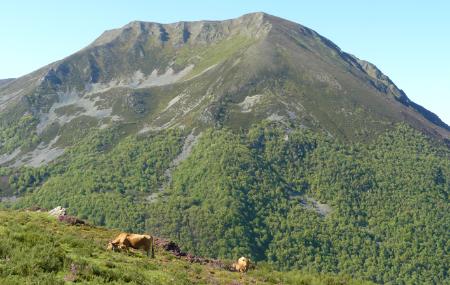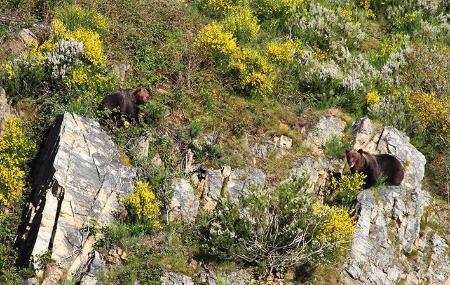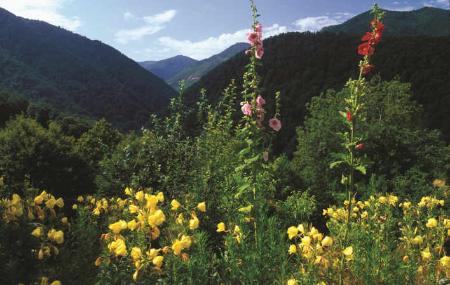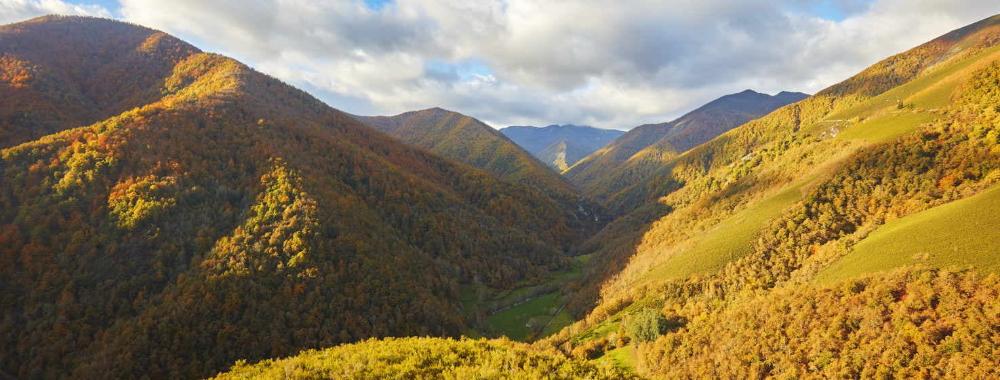
Fuentes del Narcea, Degaña and Ibias Natural Park
- Title Cangas del Narcea, Degaña e Ibias Western Asturias
- Extension Extension: 555 km 2
- Open to the public Open to the public: All year round
- Maximum elevation Maximum elevation: 2,002 m. on the Cueto de Arbas Peak
Images
What to see
- House of the Natural Park of Fuentes del Narcea, Degaña and Ibias. Courias (Cangas del Narcea).
- Nature Classroom and Interpretation Centre of the Palloza de Ibias. San Antolin (Ibias).
- Interpretation and Information Centre of the Natural Park of Fuentes del Narcea, Degaña and Ibias "Casa Florencio". Zarréu (Degaña)
- Wine Museum (Cangas del Narcea).
- Routes: Cueto de Arbas Lagoon (Cangas del Narcea), Pomar de las Montañas (Cangas del Narcea), Chagüeños Lagoon (Degaña), Dolmen da Hucha (Ibias).
- Protected areas in the Park: Muniellos Integral Nature Reserve ( Cangas del Narcea and Ibias).
- Alto del Acebo viewpoint (Cangas del Narcea).
- Wood craftsmen (the tixileiros or cunqueiros).
- Code of GOOD PRACTICES.
- This is the sound of Las Fuentes del Narcea, Degaña and Ibias.
Info
In the Fuentes del Narcea, Degaña and Ibias Natural Park, dogs must be under the effective control of their owner, kept on a leash, except for herd guarding dogs, hunting dogs and guide dogs.
With an extension of 555 square kilometres, the Natural Park of Fuentes del Narcea, Degaña and Ibias was declared Natural Park in 2002 and Biosphere Reserve in 2003. It has one of the richest natures of the Cantabrian Sea. The park also contains two other natural areas of great interest: the Munieḷḷos Forest Integral Nature Reserve and the Cueto de Arbas Partial Nature Reserve.
The landscape of the park offers a great variety of nuances, which are defined with personality in each of the councils that make it up: in the area of Cangas del Narcea, the relief is abrupt and rugged as the Narcea River flows through it and its numerous tributaries are ideal spaces for trout and salmon fishing. This area includes part of the fascinating Munieḷḷos forest, whose visit is restricted in order to preserve its exceptional nature intact. In other forest areas of the council, hunting of some of its numerous wild species such as roe deer or wild boar is permitted.
In the council of Degaña there are many high mountain ranges and green valleys. Its landscape is one of the most typical ecosystems of the Cantabrian Mountains. It is notable for its oak groves and other species, such as birch, yew, holly... as well as its wildlife, which includes endangered species such as the bear, wild cat and capercaillie. Degaña is, in turn, a Regional Hunting Reserve, highly appreciated by lovers of this discipline.
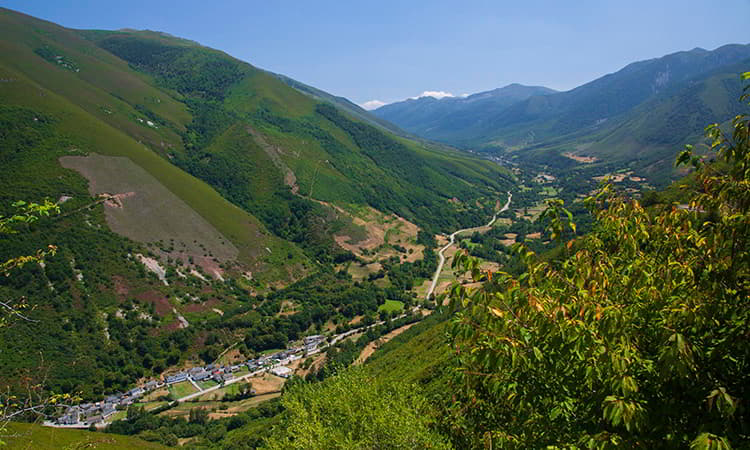
The third council included in the park is Ibias. This is an area with great mountainous relief which, without being too steep, gives the landscape great beauty and rich vegetation. The Valdebois mountain, in the Munieḷḷos forest, is its most important enclave. The sources of the river Ibias and its tributaries bathe the mountain ranges and valleys with crystalline waters. Ibias has testimonies that prove its population in the Neolithic period and in the castreña and Roman periods. Dolmens in Pradías and Chao Leda merge history, culture and art with the spectacular nature of places such as Munieḷḷos or the Ancares.
The popular architecture of hórreos and pallozas, which are an evolution of the castreña house, stands out throughout the council of Ibias.
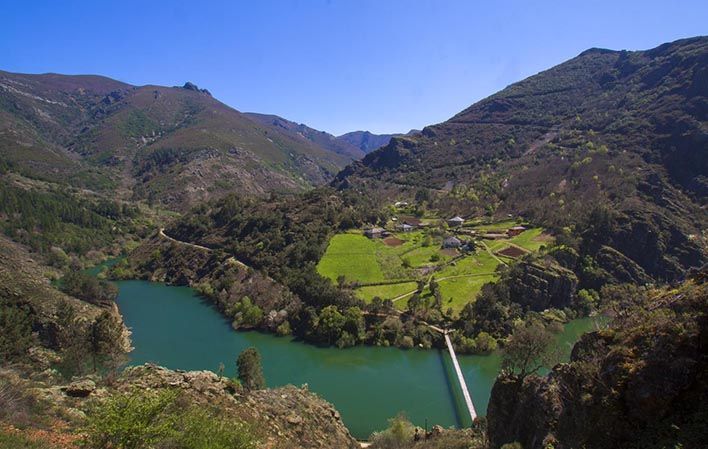
Plant life
The Park's vegetation is characterised by its large extension of oak and beech forests. The most important of the latter, due to its size and state of conservation, is the beech forest of the Hermo valley, which occupies 10 kilometres of hillside. The forests at the headwaters of the Ibias and Molín rivers are also representative. The oak groves are distributed throughout the area, the best example of sessile oak being the Munieḷḷos forest.
In Degaña, in the upper basin of the Naviego or on the ascent to the Connio pass, birch trees abound. In the high mountains, the vegetation is made up of juniper, heather and blueberry bushes, with those of the Cueto de Arbas being very characteristic.
Wildlife
The most representative of the Park's fauna is, without doubt, the Cantabrian brown bear. The conditions of the area, its extensive forests and inaccessible refuge areas, make it an excellent place for its development and survival. Although its numbers have been considerably reduced in recent decades, it is undoubtedly the animal that is the hallmark of the Asturian forests.
The wolf also maintains an important population, with stable breeding areas and relatively important family groups. And, in the large expanses of woodland and scrubland, there are numerous roe deer and chamois. Among the birds, it is worth mentioning the capercaillie, an endangered animal, which finds its habitat in the forests of Hermo, Degaña and Munieḷḷos. In most of the rivers, whose waters abound with trout and salmon, the protected presence of the otter can be observed.
Map
Location
The Fuentes del Narcea, Degaña and Ibias Natural Park is located in the south-western sector of Asturias and covers the upper basin of the Ibias and Narcea rivers, and runs through the councils of Cangas del Narcea, Degaña and Ibias.
House of the Natural Park of
Sources of Narcea, Degaña
and Ibias
33816 Courias Cangas del Narcea
985 813 981
pnfuentes@tragsa.es
Interpretation and Information Centre of the
Parque Natural de las Fuentes del Narcea, Degaña e Ibias "Casa Florencio" 33812 Zarréu.
33812 Zarréu Degaña
610 588 462
info@rednaturaldeasturias.es
Nature Classroom and Interpretation Centre
de la Palloza de Ibias
33810. San Antolin, Ibias
615 164 329
info@rednaturaldeasturias.es



